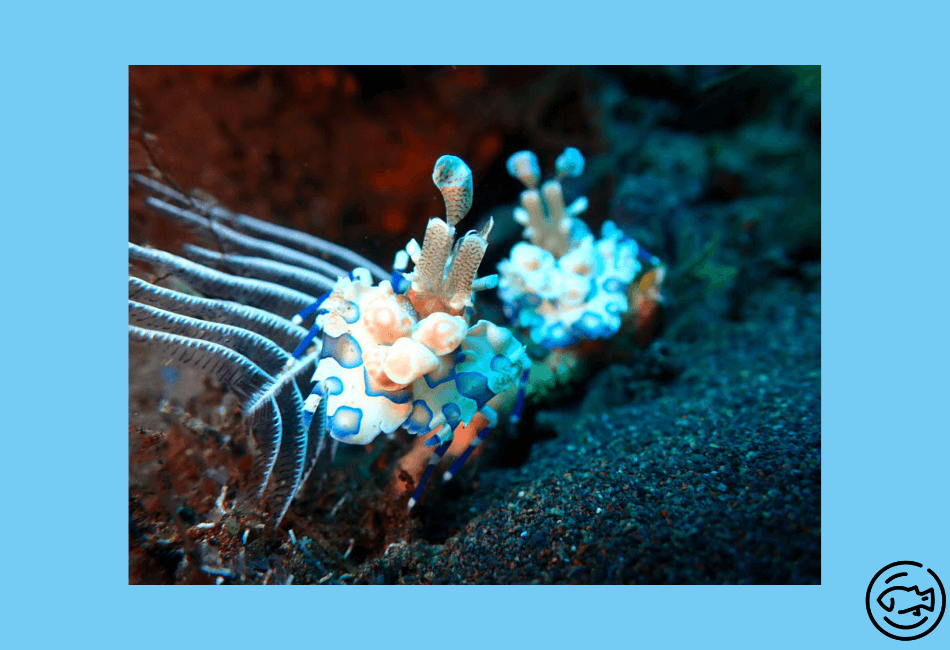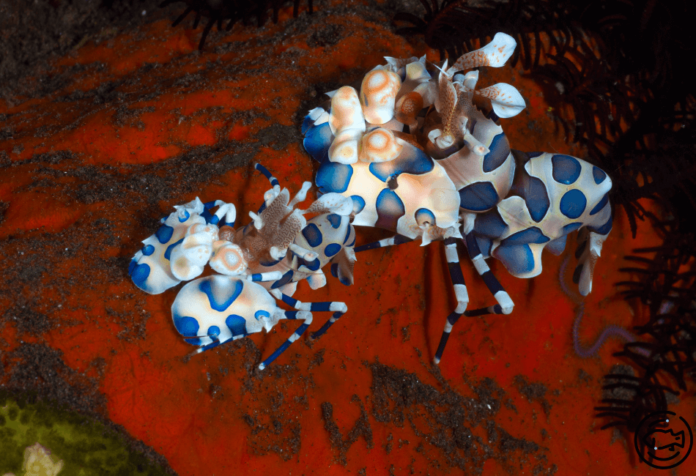We’re excited for you to discover the incredible Harlequin Shrimp in this comprehensive care guide. This shrimp is highly sought after, and you’ll soon understand its appeal.
In this guide, you’ll learn a wealth of information about these shrimp, from their unique dietary preferences to the optimal method of pairing them in aquariums!
Overview
Harlequin Shrimp, scientifically referred to as Hymenocera picta, is occasionally called Clown Shrimp or Painted Shrimp. These distinctive carnivorous species bring a stunning visual element to aquariums while showcasing fascinating predatory behaviors.
Unlike many shrimp that scavenge for food, Harlequins are adept hunters with a diet consisting solely of starfish. They possess a natural immunity to the toxins their prey releases.
Some marine biologists theorize that they absorb the venom and use it as a defense against their predators.
These widely distributed shrimp inhabit the warm waters of the Indian and Pacific Oceans. Reef divers can spot Harlequins off the coasts of East Africa, Australia, Hawaii, Indonesia, Panama, and the Galapagos Islands.
Harlequin Shrimp typically seek shelter in crevices and caves where they can hide between hunting forays.
In the wild, Harlequins remain within 100 feet of the surface and maintain well-defined territorial boundaries with other shrimp. Researchers have noted intricate social connections between lifelong bonded pairs of Harlequins, who work together to hunt and fend off predators.
Appearance

Harlequin shrimps stand out as some of the most eye-catching crustaceans. They sport a cream hue adorned with brownish-orange to vivid pink spots encircled by blue borders.
Their shape resembles other shrimp species, with elongated legs in proportion to their body size. However, their claws and eyes are flatter compared to their counterparts.
Harlequins possess a pair of leaf-like sensory antennules near their eyes, which they use to detect and track their prey. Males are generally considered nimbler and more proficient hunters.
The shrimp’s underside boasts eight pereiopods, legs used for crawling on coral and rocks, and ten pleopods, forked limbs utilized for swimming, spanning their abdomen.
While shopping for your tank, you might come across Blue Harlequin Shrimp. These shrimps share the same shape and cream color as the typical Harlequin Shrimp but display blue spots bordered with yellow edges.
Predominantly found in the Indian Ocean, biologists continue to debate whether the Blue Harlequin is a distinct species or a subspecies of the Harlequin Shrimp.
Lifespan
When given appropriate care and stable aquarium conditions, Harlequin Shrimp can live for up to seven years on average. They are considered to demand an intermediate level of care.
While maintaining precise tank conditions is essential, they tend to flourish once you perfect their feeding regimen and supply good hiding spots.
The primary challenge associated with caring for Harlequins is the expense of acquiring their food and maintaining the cleanliness of their tanks.
Average Size
Comprehending the size of Harlequin Shrimp is crucial for numerous aquarium enthusiasts, as larger shrimp typically come with increased expenses.
These shrimp can expand up to 2 inches in length and weigh just a couple of ounces, with females being marginally more influential than males.
Therefore, depending on your inclinations, you may invest additional funds for a more prominent shrimp or save money by nurturing a smaller, younger shrimp.
Harlequin Shrimp Care
To appropriately tend to a Harlequin Shrimp, it is essential to watch its conduct, efficiently manage its dietary needs, and consistently examine the conditions within your aquarium.
also read: Neocaridina Shrimp
Tank Size
Your Harlequin Shrimp necessitates a tank of at least 10 gallons in size. They will typically reside among rocks and coral. Their distinctive size, vibrant color pattern, and positive behavior ensure they remain noticeable, irrespective of the tank’s dimensions.
For housing a shrimp pair, experts advise using a 20-gallon or larger tank. The primary challenge when keeping shrimp in smaller tanks lies in sustaining suitable water conditions for their well-being.
Harlequin Shrimp are relatively inept swimmers and sluggish crawlers, so they cannot withstand rapid currents. These shrimp will mainly occupy coral and rubble areas, venturing out to feed before retreating to their hideout.
Diet
Scientists regard Harlequin Shrimp as specialized predators, as they are highly adapted to hunting and consuming a specific prey: starfish. In fact, numerous videos and articles showcase Harlequin Shrimp feasting on starfish as they refuse to eat anything else.
The main challenge in raising and maintaining Harlequins is acquiring starfish or sustaining a population. Thankfully, they will consume virtually any starfish species.
Harlequins can eat live or frozen and thawed starfish, however, thawed food decays faster, so watch how quickly the shrimp eats the starfish.
A starfish with a 4″ to 6″ diameter can provide up to a month’s worth of sustenance for your shrimp as starfish regenerate and shrimp consume them slowly.
Chocolate chip starfish, priced at around $8 to $15, are the most cost-effective food option.
Ensuring enough hiding spots is crucial, as the shrimp will drag its prey to its lair to feed.
Observing the shrimp’s food consumption is vital. Once the starfish dies, its remains must be promptly removed from the tank to prevent an accumulation of ammonia and other nitrogenous waste. Alternatively, you can keep a starfish in a separate tank and remove its limbs to feed your Harlequin fish.
In their natural habitat, starfish shed their limbs as a defense mechanism, and shrimp have adapted to eating these appendages. In addition to their stunning appearance and captivating behaviors, Harlequin Shrimp’s food preferences contribute to parasite control.
Asterina starfish, often found in reef tanks hitching a ride on rocks and other objects, can cause problems when their population grows unchecked, as they feed on coral.
Your Harlequin, a skillful hunter, will devour Asterina, preserving your tank’s beauty while reducing its reliance on the starfish you supply. This approach safeguards your tank and lowers feeding expenses. You can also cultivate an Asterina colony in a separate tank to use as food.
Behavior
In addition to their predatory habits, you’ll have the chance to witness your Harlequin’s molting process. Like all shrimp, they possess an exoskeleton that protects their delicate body.
As the shrimp grows, it forms a new exoskeleton to accommodate its larger size and discards the old one. You’ll be able to see your shrimp emerge from its former shell, similar to a butterfly leaving its cocoon.
Upon forming, the new exoskeleton is initially soft, so your shrimp will spend more time concealed in its hiding spot during the first few days post-molting, allowing its shell to harden.
Observing their distinctive behaviors is one of the greatest pleasures of owning Harlequin Shrimp.
Though they are fierce starfish hunters, these shrimp are gentle with fish and other invertebrates. They will explore the tank coral and typically fare better when housed with a mate.
Harlequins display territorial and aggressive behavior only towards other shrimp species and Harlequin Shrimp of the same gender. Housing two males or two females together can result in aggression, with males even fighting to the death in some cases.
A bonded Harlequin pair will work closely in unison, staying side by side for protection while jointly hunting starfish.
Tank Requirements
When designing your aquarium, it’s essential to replicate the natural environment of your Harlequin Shrimp and consider their behaviors. Surprisingly, providing plenty of hiding places with caves, rocks, and crevices makes your shrimp more visible.
If they feel safe and have cozy hiding spots, the shrimp will be more daring and roam the tank. Without shelter, their defensive instincts activate, causing them to hide constantly.
This prevents you from enjoying your shrimp and deprives them of food, as they will be too cautious about hunting and feeding.
Fake plants and hollow plastic structures like ships are all suitable, and your shrimp will examine rock and coral without causing damage. If you intend to keep a pair of shrimp, provide an ample hiding space to accommodate both Harlequins.
Water Conditions
pH levels: Maintain pH within the range of 8.0 and 8.4
Water hardness: Aim for a level between 8 and 12 dKH
Water temperature: 72°F to 82°F
Specific gravity: Optimal salinity falls between 1.020 and 1.024 sg
Similar to other crustaceans, Harlequin Shrimp are susceptible to ammonia, nitrite, and nitrate generated by nitrogenous waste.
Keeping these compounds at 0 ppm offers your shrimp the most significant opportunity for flourishing.
Diseases
Though not susceptible to specific illnesses, Harlequin Shrimp are highly sensitive to even the slightest changes in aquarium conditions.
It’s crucial to remove molted shells, deceased fish, starfish remnants, and other decomposing materials that can release ammonia or nitrates.
Moreover, these shrimp cannot withstand even minimal levels of copper. Make sure to check the composition before introducing anything to your tank.
Conclusion
It’s evident that these shrimp captivate attention for their striking appearance and vivid colors and their atypical diet and disposition.
This unique combination is likely why they enjoy such popularity in our various care guides and among numerous shrimp aficionados.
We’d be delighted to hear your stories if you’re a Harlequin Shrimp owner.
Over the years, we’ve encountered many fascinating tales about these shrimp, and it would be enjoyable to start incorporating some into our guide.



